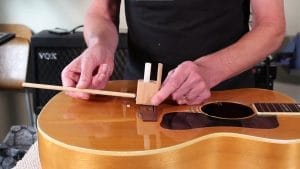Table of Contents
For those passionate about both classical and contemporary styles like myself, the Yamaha NTX1 is a remarkable instrument that delivers a harmonious fusion of tradition and innovation.
Whether you’re a seasoned performer or an aspiring musician seeking an instrument that can adapt to various musical genres, this guitar presents an exciting world of possibilities.
With its exquisite craftsmanship, cutting-edge features, and rich tonal palette, this guitar is a testament to Yamaha’s commitment to delivering exceptional instruments to musicians worldwide.

| Made In | China, Japan, Indonesia |
| Model | Yamaha Ntx1 |
| Body | Nato |
| Top | Solid Sitka spruce |
| Neck | Nato |
| Scale | 25.5″ |
| Nut Width | 1.875″ |
| Weight | 5.5 pounds |
| Fretboard | Walnut |
| Frets | 22 |
| Bracing | NX Bracing |
| Electronics | Yamaha preamp system |
| Bridge | Ebony |
| Inlays | N/A |
| Truss Rod | N/A |
| Case | N/A |
| Design | Designed for electric and steel-string players. |
| Colors | Black, Brown, and Natural |
As a versatile nylon-string acoustic-electric guitar, this guitar offers musicians a gateway to explore a multitude of genres with exceptional sound quality and a comfortable playing experience.
Before diving in, would you like to check out some of the best classical guitar brands?
Body
Yamaha NTX1 has a single cutaway body. According to my experience, this body is a great balance of traditional and modern design. It does have a comparatively thinner body. The solid Sitka spruce top gives the guitar a bright, clear sound that is perfect for classical music.
Learn more about guitar body shapes and how they can affect the tonality.
However, The nato wood used for the back and sides of the NTX1 also left a lasting impression. In my firsthand encounter, I noticed that the nato wood provided a warm and rich tonal character, adding depth and richness to the overall sound.
It created a solid foundation for the guitar’s tone, enhancing the instrument’s tonal balance and allowing each note to resonate with warmth and clarity.
The body is also very comfortable to play. The fretboard is constructed of walnut, and the neck is a comforting C shape. As a guitarist who enjoys exploring the higher frets and employing intricate fingerstyle techniques, easy access to the upper registers is invaluable.
I was able to effortlessly navigate the fretboard, unleashing the full range of the guitar’s capabilities and expressing my musical ideas without any limitations. The overall feel of the guitar is very well-balanced, making it easy to play for long periods.
Bracing
As I explored the depths of the guitar’s tonal capabilities, I discovered that Yamaha had greatly refined the NX bracing system specifically for the NTX1 through extensive experimentation and precise measurement.
Luthiers found some ways to make the instrument even better. They focused on improving the low-end sound, and because of their attention to detail, the bass now sounds more pronounced and impactful, making my playing sound deeper and richer.
Plus, they tweaked the design of the internal supports in the guitar (the bracing), and this made the NTX1 bring out the natural sound of the wood they used. Every time I strum or pluck the strings, you can hear the unique qualities of the solid Sitka spruce top and nato back and sides. These woods each have their special sound, and when they come together, it create a beautiful blend of warmth, clarity, and resonance.
Do you need help changing your classical guitar strings? Here is a guide for you to help you out.

Electronics
I recently had the opportunity to play the Yamaha NTX1 at a live gig. I was immediately impressed with the sound of the guitar plugged in. This guitar is truly ready to plug in and play out, thanks to its powerful under-saddle pickup and advanced Yamaha preamp system.
Equipped with the under-saddle pickup, the NTX1 allowed me to amplify my sound for performances on stage effortlessly. The pickup captured the natural nuances and dynamics of my playing, faithfully translating them into a vibrant and expressive electric tone. It was as if the guitar came alive, projecting my music with clarity and precision.
The advanced Yamaha preamp system further enhanced my playing experience. With the onboard 3-band EQ, I had complete control over shaping my sound to suit any venue or musical style. Whether I wanted to emphasize the rich lows, bring out the sparkling highs, or find the perfect balance in between, the NTX1’s preamp system allowed me to sculpt my tone with ease and precision.
One of the standout features of the NTX1’s preamp system was the onboard tuner. This invaluable tool eliminated the need for external tuners or pedals, simplifying my setup and ensuring that I was always in tune. With just a glance at the conveniently placed tuner, I could fine-tune my instrument effortlessly, saving time and allowing me to focus on my performance.
To tune your guitar perfectly, here is a list of methods that can help you.
Bridge
The Yamaha NTX1 has a solid ebony bridge with a compensated saddle. The ebony bridge is a very dense and hard wood that is known for its excellent tonal qualities. The compensated saddle helps to ensure that the guitar stays in tune even when you play different chords or scales.
I also really like the way the bridge projects the sound of the guitar. The bridge has a slightly arched top, which helps to increase the resonance of the guitar. The bridge also has a cutout in the center, which helps to project the sound of the high strings.
Pros & Cons of Yamaha Ntx1
- Versatility: The NTX1 is a versatile instrument that can adapt to different musical genres and playing styles.
- Onboard Tuner: The NTX1 features an onboard tuner, eliminating the need for external tuning devices or pedals.
- Acoustic-Electric Capabilities: The NTX1 is equipped with an under-saddle pickup and an advanced Yamaha preamp system, offering seamless integration between acoustic and electric realms.
Cons of Yamaha Ntx1
- Nylon String Limitations: The NTX1 is designed for nylon strings, which have a lower tension than steel strings. This makes it ideal for classical and fingerstyle playing but not as well-suited for genres that require a brighter sound.
Yamaha Ntx1 FAQs
No, the Yamaha NTX1 is designed specifically for use with nylon strings. It is not recommended to use steel strings on this guitar as it may affect the instrument’s playability and potentially damage the neck or bridge.
Modifying the NTX1’s electronics or pickups may void the warranty and could potentially affect the guitar’s performance and sound. It’s recommended to consult with a qualified guitar technician or contact Yamaha directly for guidance on any modifications.
It comes with a one-year warranty. This means that if the guitar has any defects, Yamaha will repair or replace it free of charge.
- Best 6 Left Handed Classical Guitars - February 6, 2025
- 8 Perfect Electric Guitar For Kids - February 6, 2025
- The 6 Best Nylon Guitar Strings for You in 2025 - February 6, 2025









